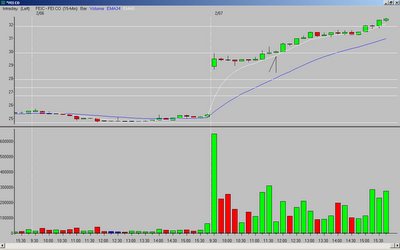
1.) What did I see?
Price gapped up and printed a wide-range first bar. The next six bars narrowed and consolidated inside the first bar's range. The rising 5MA eventually ran into that consolidation, and bars eight-ten rallied above the OR high. The tenth bar was a narrow-range (NRM), inside bar that closed above the OR high.
2.) What is the entry?
A break of the tenth bar high.
3.) What is the exit?
The target was the Fibonacci extension of the previous day's low to the OR high; it was hit in the last hour of the day.
Set-up grade = "A"
_______________
Tags:
trader-x, stocks, fibonacci, trading, feic



16 comments:
This just rubs salt in the wound -- I had an order out for this exact same entry but pulled it at the last minute. Damn.
What made you pull it?
X, I was concerned about the previous bar's long upper shadow and the entry bar's lack of intersection with either the OR high or the 5eMA. However, 9 times out of 10, I regret pulling my order once I've opened it; if I thought enough of the setup to place an order in the first place, then I should not be second guessing myself.
Anyway, great job catching this one!
I see. I like those long upper tails as long as price does not take out that bar's low first...if price takes out the high of the long upper tail, it usually rallies good provided it is coming off some kind of support.
a little confused- did u take the 8th bar trigger entry as well? before it traded down to where it closed giving it the long wick- it looked great- trading thru OR, off 5ma, increased volume- or am i missing something? thanks pete
Thanks for the advice. In addition, the bar with the long upper tail managed to close just above the OR high -- another nice bullish signal here. Again, I should have never pulled my order.
estocastica, that wasn't advice. You could be giving me advice!
pete, buying the eighth bar as it broke the seventh bar high is a valid entry - it just had more risk as the seventh bar was below the OR low.
x, i have watched gaps long enough to see that the method you follow works. however,and i ask this only as clarification. aren't these set ups more prone to fail than to win. i 'm refering here to the larry connors studies, which by now form a body of sixteen indicators, in trading markets.com. in their studies, gaps of 5% or more are negative and over s large sample of trades, more likely to losing than winning. how do you reconcile this. perhaps there is a piece missing. because if their studies are true and they sell systems etc, based on them. you stand to lose more than to win on these gap trades. this is offered only in the spirit of clarification. i've seen the trades work. yet i ask out of 1oo times, how many will be losers, stopped out, or winners.
leon t, that is not my experience at all. My win rate is very high. I don't trade just any gap - I am very selective. I study price action and look for a solid set-up. That is what this blog is all about.
I don't know anything about Connor's studies.
leon-
If you do a study based solely on stocks that gap 5% I am sure you will get the results mentioned. Your post leads me to believe you have not read much on Trader-X's blog.
So much goes into deciding whether to take a trade...analysis of price action, where it is in relation to the opening range, candle patterns, is there support from the 5MA and Fibonacci levels, narrow-range vs. wide-range bars (just to name a few considerations).
Actually understanding these things is what allows someone to achieve a higher win rate and become profitable in this business. If you are just buying or selling a stock because it gapped 5%, you will fail.
IMO, these studies of gaps and candle formations and other TA principles are laughable - by their very logic they reflect that the people doing them don't understand the first thing about how to trade. They are just gamblers trying to find odds in their favor.
Tom C.
Tom C, that is a great post. And much more eloquent than my reply!
Tom C, that was beautiful...just beautiful.
Once you enter the break of the x bar, where do you place your initial stop? And as the price chugs toward the Fibonacci extension, do you use a trailing stop? TIA
Jeff - if you read through the blog you will find all of those answers. The initial stop is the opposite extreme of the bar that triggers the trade.
X,
What is you scan criteria and what trading software do you use?
R
raj, it is all documented under "Welcome and Links to Key Posts".
TJ
Post a Comment